Leadership Assignment: Communication and Organizational Goals
VerifiedAdded on 2022/11/28
|8
|1367
|365
Homework Assignment
AI Summary
This assignment explores various aspects of leadership within an organization. It addresses the importance of communication, emphasizing how a lack thereof can negatively impact performance and create workplace conflicts. The assignment details effective strategies for communicating an organization's mission, vision, values, and goals to stakeholders and employees. It outlines the roles and responsibilities of managers in handling incidents and influencing groups and individuals. The assignment also covers team building, demonstrating professional competence, and the significance of business ethics in fostering trust and productivity. It further examines different leadership styles, the impact of legislation, and the organizational change process, providing a comprehensive overview of leadership principles and practices.
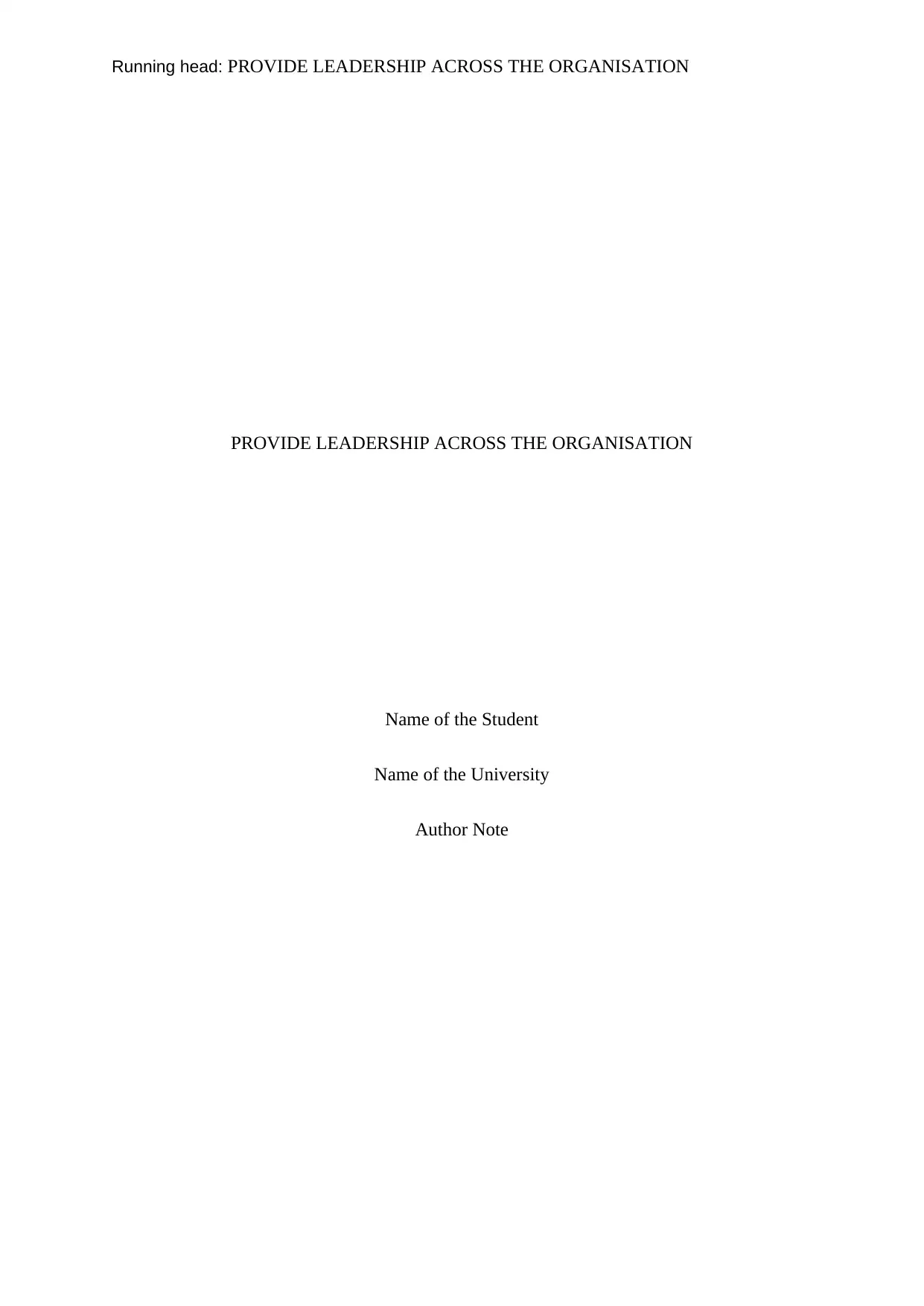
Running head: PROVIDE LEADERSHIP ACROSS THE ORGANISATION
PROVIDE LEADERSHIP ACROSS THE ORGANISATION
Name of the Student
Name of the University
Author Note
PROVIDE LEADERSHIP ACROSS THE ORGANISATION
Name of the Student
Name of the University
Author Note
Paraphrase This Document
Need a fresh take? Get an instant paraphrase of this document with our AI Paraphraser
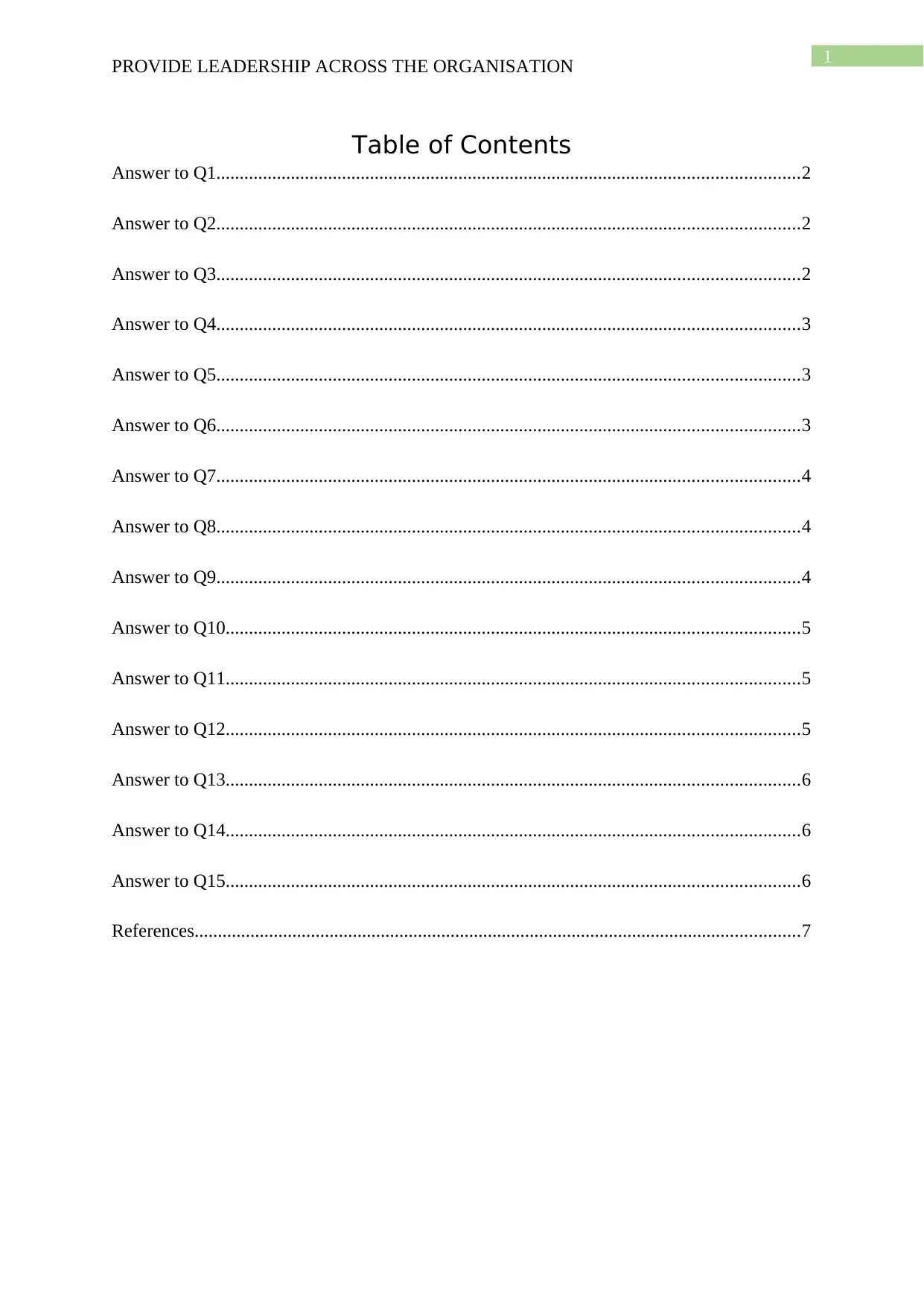
1
PROVIDE LEADERSHIP ACROSS THE ORGANISATION
Table of Contents
Answer to Q1.............................................................................................................................2
Answer to Q2.............................................................................................................................2
Answer to Q3.............................................................................................................................2
Answer to Q4.............................................................................................................................3
Answer to Q5.............................................................................................................................3
Answer to Q6.............................................................................................................................3
Answer to Q7.............................................................................................................................4
Answer to Q8.............................................................................................................................4
Answer to Q9.............................................................................................................................4
Answer to Q10...........................................................................................................................5
Answer to Q11...........................................................................................................................5
Answer to Q12...........................................................................................................................5
Answer to Q13...........................................................................................................................6
Answer to Q14...........................................................................................................................6
Answer to Q15...........................................................................................................................6
References..................................................................................................................................7
PROVIDE LEADERSHIP ACROSS THE ORGANISATION
Table of Contents
Answer to Q1.............................................................................................................................2
Answer to Q2.............................................................................................................................2
Answer to Q3.............................................................................................................................2
Answer to Q4.............................................................................................................................3
Answer to Q5.............................................................................................................................3
Answer to Q6.............................................................................................................................3
Answer to Q7.............................................................................................................................4
Answer to Q8.............................................................................................................................4
Answer to Q9.............................................................................................................................4
Answer to Q10...........................................................................................................................5
Answer to Q11...........................................................................................................................5
Answer to Q12...........................................................................................................................5
Answer to Q13...........................................................................................................................6
Answer to Q14...........................................................................................................................6
Answer to Q15...........................................................................................................................6
References..................................................................................................................................7
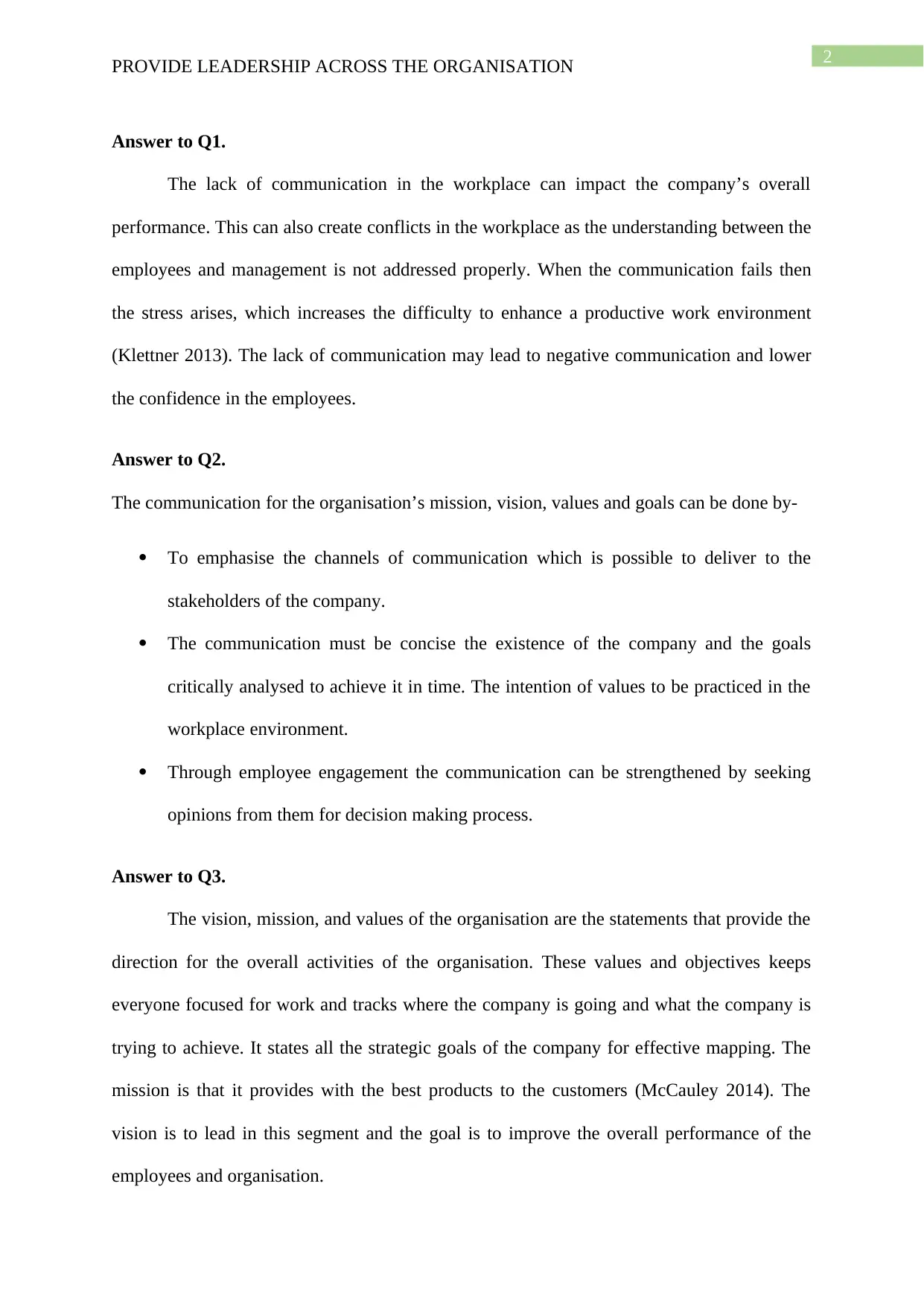
2
PROVIDE LEADERSHIP ACROSS THE ORGANISATION
Answer to Q1.
The lack of communication in the workplace can impact the company’s overall
performance. This can also create conflicts in the workplace as the understanding between the
employees and management is not addressed properly. When the communication fails then
the stress arises, which increases the difficulty to enhance a productive work environment
(Klettner 2013). The lack of communication may lead to negative communication and lower
the confidence in the employees.
Answer to Q2.
The communication for the organisation’s mission, vision, values and goals can be done by-
To emphasise the channels of communication which is possible to deliver to the
stakeholders of the company.
The communication must be concise the existence of the company and the goals
critically analysed to achieve it in time. The intention of values to be practiced in the
workplace environment.
Through employee engagement the communication can be strengthened by seeking
opinions from them for decision making process.
Answer to Q3.
The vision, mission, and values of the organisation are the statements that provide the
direction for the overall activities of the organisation. These values and objectives keeps
everyone focused for work and tracks where the company is going and what the company is
trying to achieve. It states all the strategic goals of the company for effective mapping. The
mission is that it provides with the best products to the customers (McCauley 2014). The
vision is to lead in this segment and the goal is to improve the overall performance of the
employees and organisation.
PROVIDE LEADERSHIP ACROSS THE ORGANISATION
Answer to Q1.
The lack of communication in the workplace can impact the company’s overall
performance. This can also create conflicts in the workplace as the understanding between the
employees and management is not addressed properly. When the communication fails then
the stress arises, which increases the difficulty to enhance a productive work environment
(Klettner 2013). The lack of communication may lead to negative communication and lower
the confidence in the employees.
Answer to Q2.
The communication for the organisation’s mission, vision, values and goals can be done by-
To emphasise the channels of communication which is possible to deliver to the
stakeholders of the company.
The communication must be concise the existence of the company and the goals
critically analysed to achieve it in time. The intention of values to be practiced in the
workplace environment.
Through employee engagement the communication can be strengthened by seeking
opinions from them for decision making process.
Answer to Q3.
The vision, mission, and values of the organisation are the statements that provide the
direction for the overall activities of the organisation. These values and objectives keeps
everyone focused for work and tracks where the company is going and what the company is
trying to achieve. It states all the strategic goals of the company for effective mapping. The
mission is that it provides with the best products to the customers (McCauley 2014). The
vision is to lead in this segment and the goal is to improve the overall performance of the
employees and organisation.
⊘ This is a preview!⊘
Do you want full access?
Subscribe today to unlock all pages.

Trusted by 1+ million students worldwide
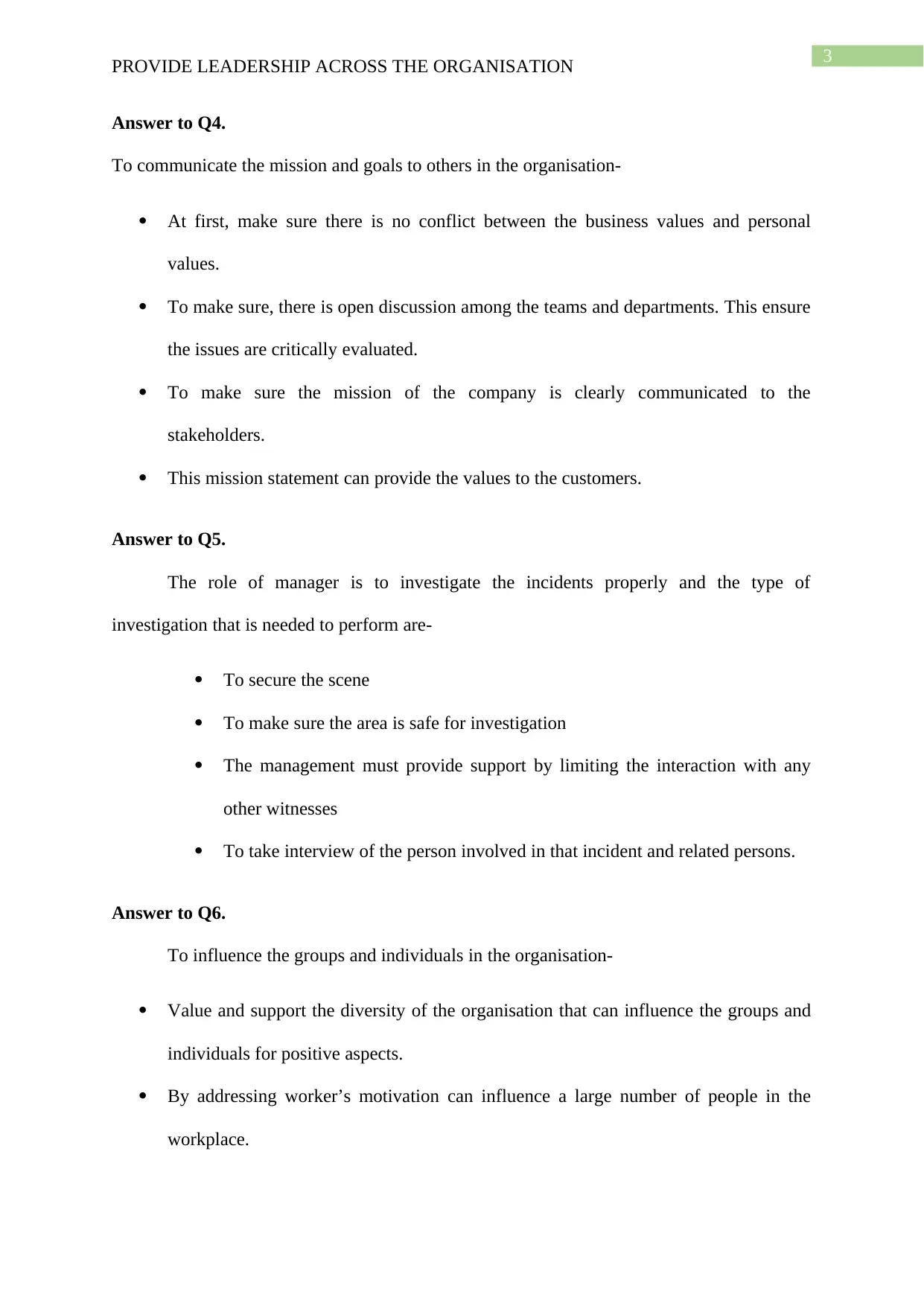
3
PROVIDE LEADERSHIP ACROSS THE ORGANISATION
Answer to Q4.
To communicate the mission and goals to others in the organisation-
At first, make sure there is no conflict between the business values and personal
values.
To make sure, there is open discussion among the teams and departments. This ensure
the issues are critically evaluated.
To make sure the mission of the company is clearly communicated to the
stakeholders.
This mission statement can provide the values to the customers.
Answer to Q5.
The role of manager is to investigate the incidents properly and the type of
investigation that is needed to perform are-
To secure the scene
To make sure the area is safe for investigation
The management must provide support by limiting the interaction with any
other witnesses
To take interview of the person involved in that incident and related persons.
Answer to Q6.
To influence the groups and individuals in the organisation-
Value and support the diversity of the organisation that can influence the groups and
individuals for positive aspects.
By addressing worker’s motivation can influence a large number of people in the
workplace.
PROVIDE LEADERSHIP ACROSS THE ORGANISATION
Answer to Q4.
To communicate the mission and goals to others in the organisation-
At first, make sure there is no conflict between the business values and personal
values.
To make sure, there is open discussion among the teams and departments. This ensure
the issues are critically evaluated.
To make sure the mission of the company is clearly communicated to the
stakeholders.
This mission statement can provide the values to the customers.
Answer to Q5.
The role of manager is to investigate the incidents properly and the type of
investigation that is needed to perform are-
To secure the scene
To make sure the area is safe for investigation
The management must provide support by limiting the interaction with any
other witnesses
To take interview of the person involved in that incident and related persons.
Answer to Q6.
To influence the groups and individuals in the organisation-
Value and support the diversity of the organisation that can influence the groups and
individuals for positive aspects.
By addressing worker’s motivation can influence a large number of people in the
workplace.
Paraphrase This Document
Need a fresh take? Get an instant paraphrase of this document with our AI Paraphraser
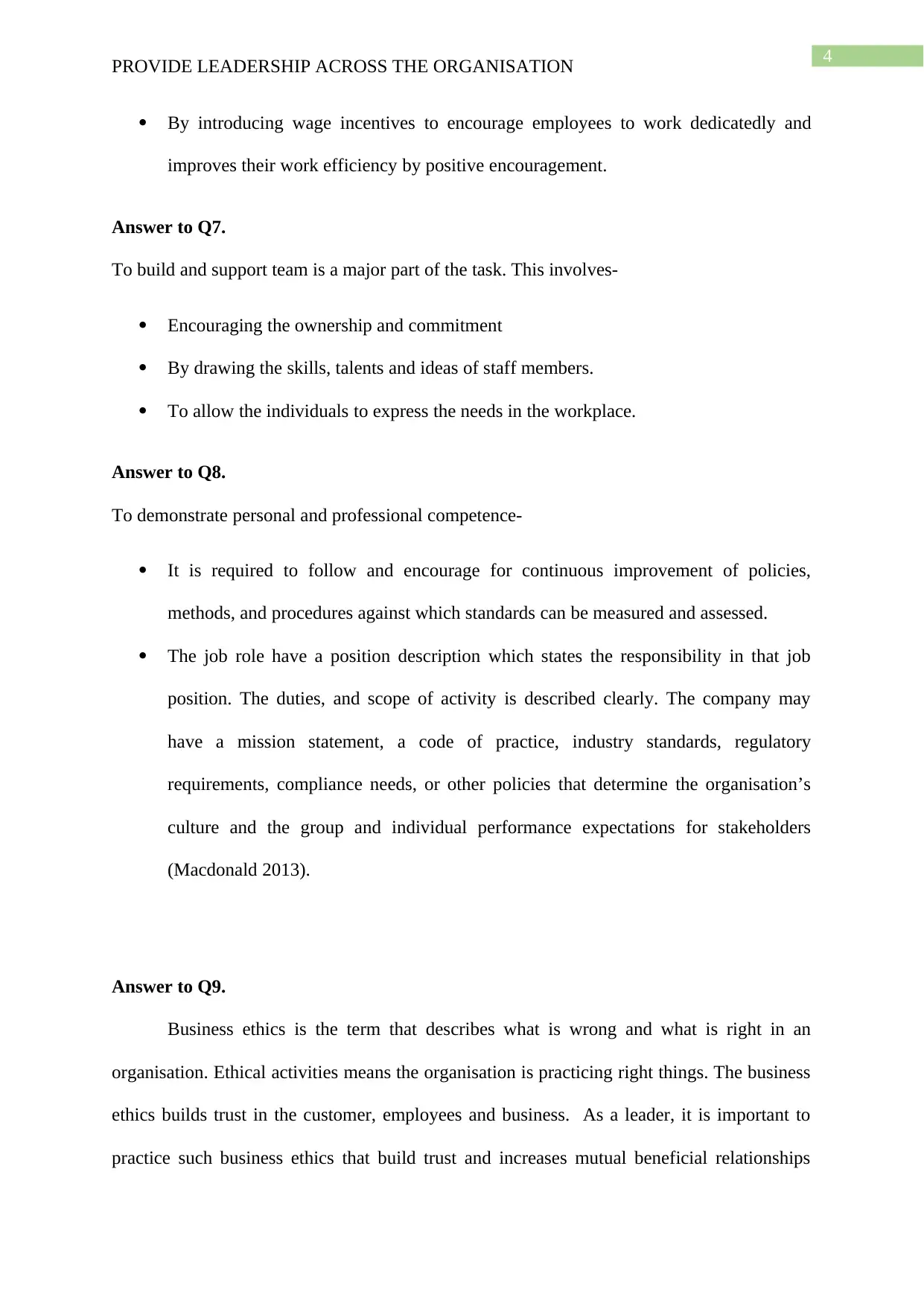
4
PROVIDE LEADERSHIP ACROSS THE ORGANISATION
By introducing wage incentives to encourage employees to work dedicatedly and
improves their work efficiency by positive encouragement.
Answer to Q7.
To build and support team is a major part of the task. This involves-
Encouraging the ownership and commitment
By drawing the skills, talents and ideas of staff members.
To allow the individuals to express the needs in the workplace.
Answer to Q8.
To demonstrate personal and professional competence-
It is required to follow and encourage for continuous improvement of policies,
methods, and procedures against which standards can be measured and assessed.
The job role have a position description which states the responsibility in that job
position. The duties, and scope of activity is described clearly. The company may
have a mission statement, a code of practice, industry standards, regulatory
requirements, compliance needs, or other policies that determine the organisation’s
culture and the group and individual performance expectations for stakeholders
(Macdonald 2013).
Answer to Q9.
Business ethics is the term that describes what is wrong and what is right in an
organisation. Ethical activities means the organisation is practicing right things. The business
ethics builds trust in the customer, employees and business. As a leader, it is important to
practice such business ethics that build trust and increases mutual beneficial relationships
PROVIDE LEADERSHIP ACROSS THE ORGANISATION
By introducing wage incentives to encourage employees to work dedicatedly and
improves their work efficiency by positive encouragement.
Answer to Q7.
To build and support team is a major part of the task. This involves-
Encouraging the ownership and commitment
By drawing the skills, talents and ideas of staff members.
To allow the individuals to express the needs in the workplace.
Answer to Q8.
To demonstrate personal and professional competence-
It is required to follow and encourage for continuous improvement of policies,
methods, and procedures against which standards can be measured and assessed.
The job role have a position description which states the responsibility in that job
position. The duties, and scope of activity is described clearly. The company may
have a mission statement, a code of practice, industry standards, regulatory
requirements, compliance needs, or other policies that determine the organisation’s
culture and the group and individual performance expectations for stakeholders
(Macdonald 2013).
Answer to Q9.
Business ethics is the term that describes what is wrong and what is right in an
organisation. Ethical activities means the organisation is practicing right things. The business
ethics builds trust in the customer, employees and business. As a leader, it is important to
practice such business ethics that build trust and increases mutual beneficial relationships
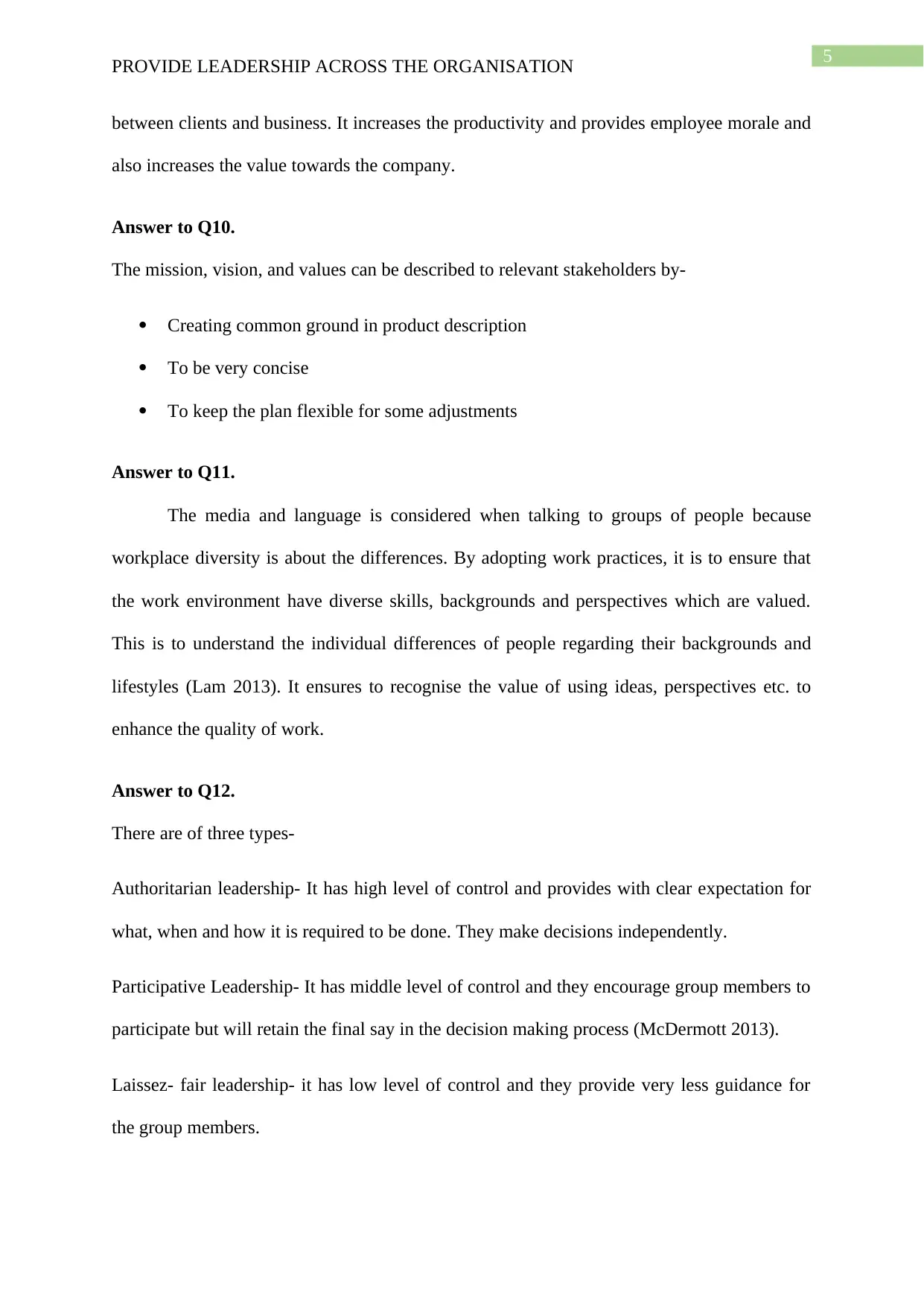
5
PROVIDE LEADERSHIP ACROSS THE ORGANISATION
between clients and business. It increases the productivity and provides employee morale and
also increases the value towards the company.
Answer to Q10.
The mission, vision, and values can be described to relevant stakeholders by-
Creating common ground in product description
To be very concise
To keep the plan flexible for some adjustments
Answer to Q11.
The media and language is considered when talking to groups of people because
workplace diversity is about the differences. By adopting work practices, it is to ensure that
the work environment have diverse skills, backgrounds and perspectives which are valued.
This is to understand the individual differences of people regarding their backgrounds and
lifestyles (Lam 2013). It ensures to recognise the value of using ideas, perspectives etc. to
enhance the quality of work.
Answer to Q12.
There are of three types-
Authoritarian leadership- It has high level of control and provides with clear expectation for
what, when and how it is required to be done. They make decisions independently.
Participative Leadership- It has middle level of control and they encourage group members to
participate but will retain the final say in the decision making process (McDermott 2013).
Laissez- fair leadership- it has low level of control and they provide very less guidance for
the group members.
PROVIDE LEADERSHIP ACROSS THE ORGANISATION
between clients and business. It increases the productivity and provides employee morale and
also increases the value towards the company.
Answer to Q10.
The mission, vision, and values can be described to relevant stakeholders by-
Creating common ground in product description
To be very concise
To keep the plan flexible for some adjustments
Answer to Q11.
The media and language is considered when talking to groups of people because
workplace diversity is about the differences. By adopting work practices, it is to ensure that
the work environment have diverse skills, backgrounds and perspectives which are valued.
This is to understand the individual differences of people regarding their backgrounds and
lifestyles (Lam 2013). It ensures to recognise the value of using ideas, perspectives etc. to
enhance the quality of work.
Answer to Q12.
There are of three types-
Authoritarian leadership- It has high level of control and provides with clear expectation for
what, when and how it is required to be done. They make decisions independently.
Participative Leadership- It has middle level of control and they encourage group members to
participate but will retain the final say in the decision making process (McDermott 2013).
Laissez- fair leadership- it has low level of control and they provide very less guidance for
the group members.
⊘ This is a preview!⊘
Do you want full access?
Subscribe today to unlock all pages.

Trusted by 1+ million students worldwide
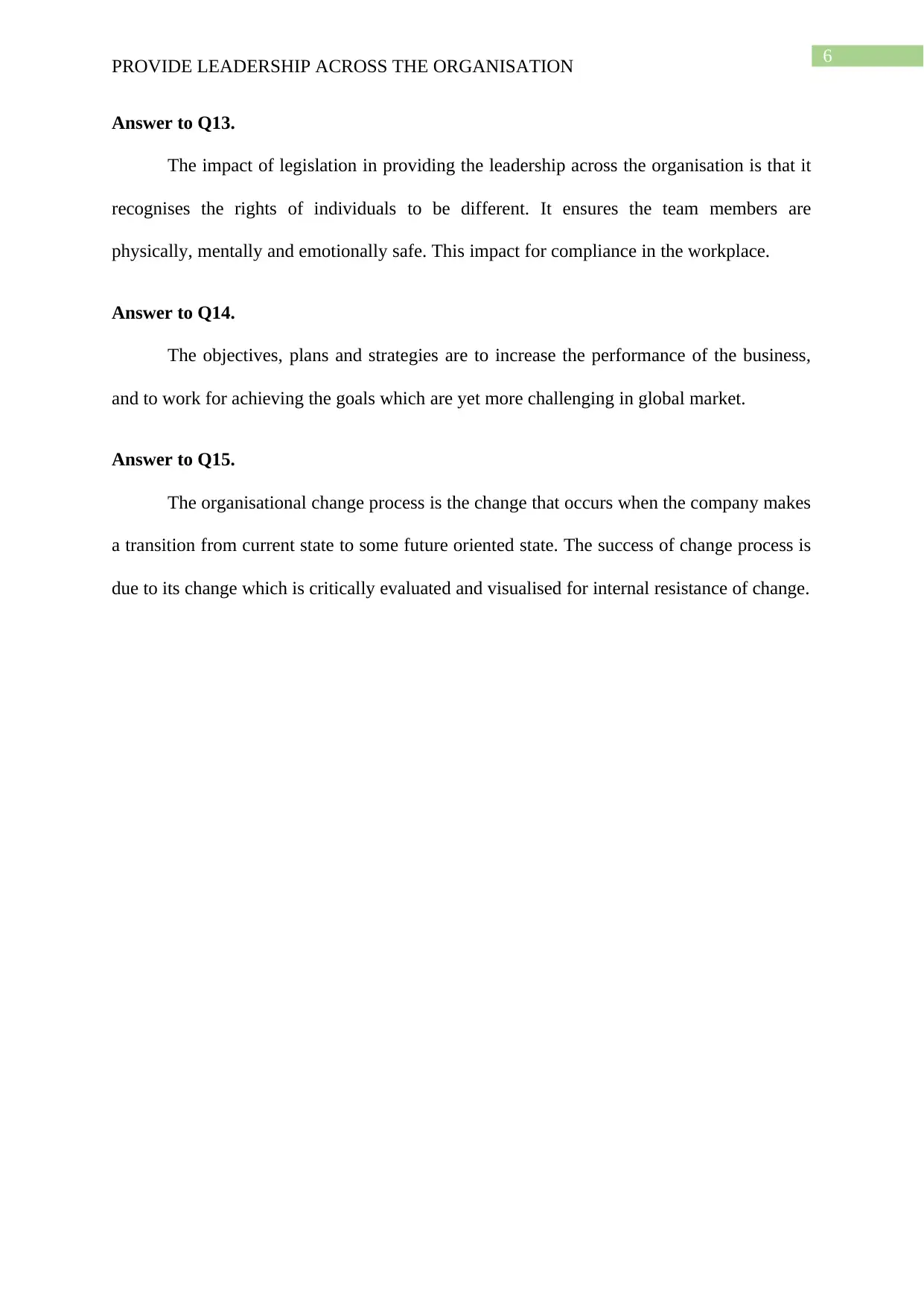
6
PROVIDE LEADERSHIP ACROSS THE ORGANISATION
Answer to Q13.
The impact of legislation in providing the leadership across the organisation is that it
recognises the rights of individuals to be different. It ensures the team members are
physically, mentally and emotionally safe. This impact for compliance in the workplace.
Answer to Q14.
The objectives, plans and strategies are to increase the performance of the business,
and to work for achieving the goals which are yet more challenging in global market.
Answer to Q15.
The organisational change process is the change that occurs when the company makes
a transition from current state to some future oriented state. The success of change process is
due to its change which is critically evaluated and visualised for internal resistance of change.
PROVIDE LEADERSHIP ACROSS THE ORGANISATION
Answer to Q13.
The impact of legislation in providing the leadership across the organisation is that it
recognises the rights of individuals to be different. It ensures the team members are
physically, mentally and emotionally safe. This impact for compliance in the workplace.
Answer to Q14.
The objectives, plans and strategies are to increase the performance of the business,
and to work for achieving the goals which are yet more challenging in global market.
Answer to Q15.
The organisational change process is the change that occurs when the company makes
a transition from current state to some future oriented state. The success of change process is
due to its change which is critically evaluated and visualised for internal resistance of change.
Paraphrase This Document
Need a fresh take? Get an instant paraphrase of this document with our AI Paraphraser
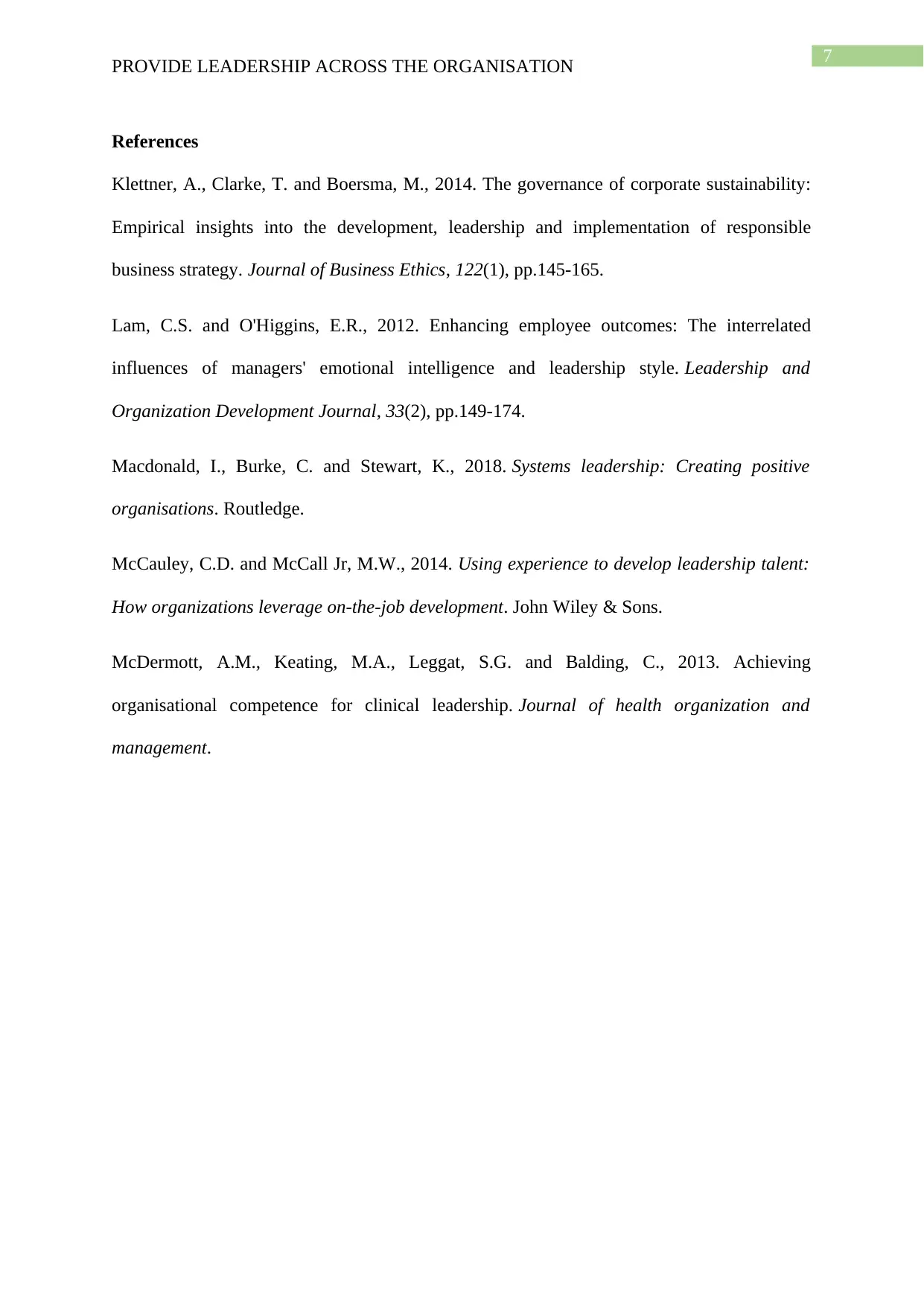
7
PROVIDE LEADERSHIP ACROSS THE ORGANISATION
References
Klettner, A., Clarke, T. and Boersma, M., 2014. The governance of corporate sustainability:
Empirical insights into the development, leadership and implementation of responsible
business strategy. Journal of Business Ethics, 122(1), pp.145-165.
Lam, C.S. and O'Higgins, E.R., 2012. Enhancing employee outcomes: The interrelated
influences of managers' emotional intelligence and leadership style. Leadership and
Organization Development Journal, 33(2), pp.149-174.
Macdonald, I., Burke, C. and Stewart, K., 2018. Systems leadership: Creating positive
organisations. Routledge.
McCauley, C.D. and McCall Jr, M.W., 2014. Using experience to develop leadership talent:
How organizations leverage on-the-job development. John Wiley & Sons.
McDermott, A.M., Keating, M.A., Leggat, S.G. and Balding, C., 2013. Achieving
organisational competence for clinical leadership. Journal of health organization and
management.
PROVIDE LEADERSHIP ACROSS THE ORGANISATION
References
Klettner, A., Clarke, T. and Boersma, M., 2014. The governance of corporate sustainability:
Empirical insights into the development, leadership and implementation of responsible
business strategy. Journal of Business Ethics, 122(1), pp.145-165.
Lam, C.S. and O'Higgins, E.R., 2012. Enhancing employee outcomes: The interrelated
influences of managers' emotional intelligence and leadership style. Leadership and
Organization Development Journal, 33(2), pp.149-174.
Macdonald, I., Burke, C. and Stewart, K., 2018. Systems leadership: Creating positive
organisations. Routledge.
McCauley, C.D. and McCall Jr, M.W., 2014. Using experience to develop leadership talent:
How organizations leverage on-the-job development. John Wiley & Sons.
McDermott, A.M., Keating, M.A., Leggat, S.G. and Balding, C., 2013. Achieving
organisational competence for clinical leadership. Journal of health organization and
management.
1 out of 8
Related Documents
Your All-in-One AI-Powered Toolkit for Academic Success.
+13062052269
info@desklib.com
Available 24*7 on WhatsApp / Email
![[object Object]](/_next/static/media/star-bottom.7253800d.svg)
Unlock your academic potential
Copyright © 2020–2025 A2Z Services. All Rights Reserved. Developed and managed by ZUCOL.




